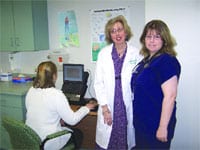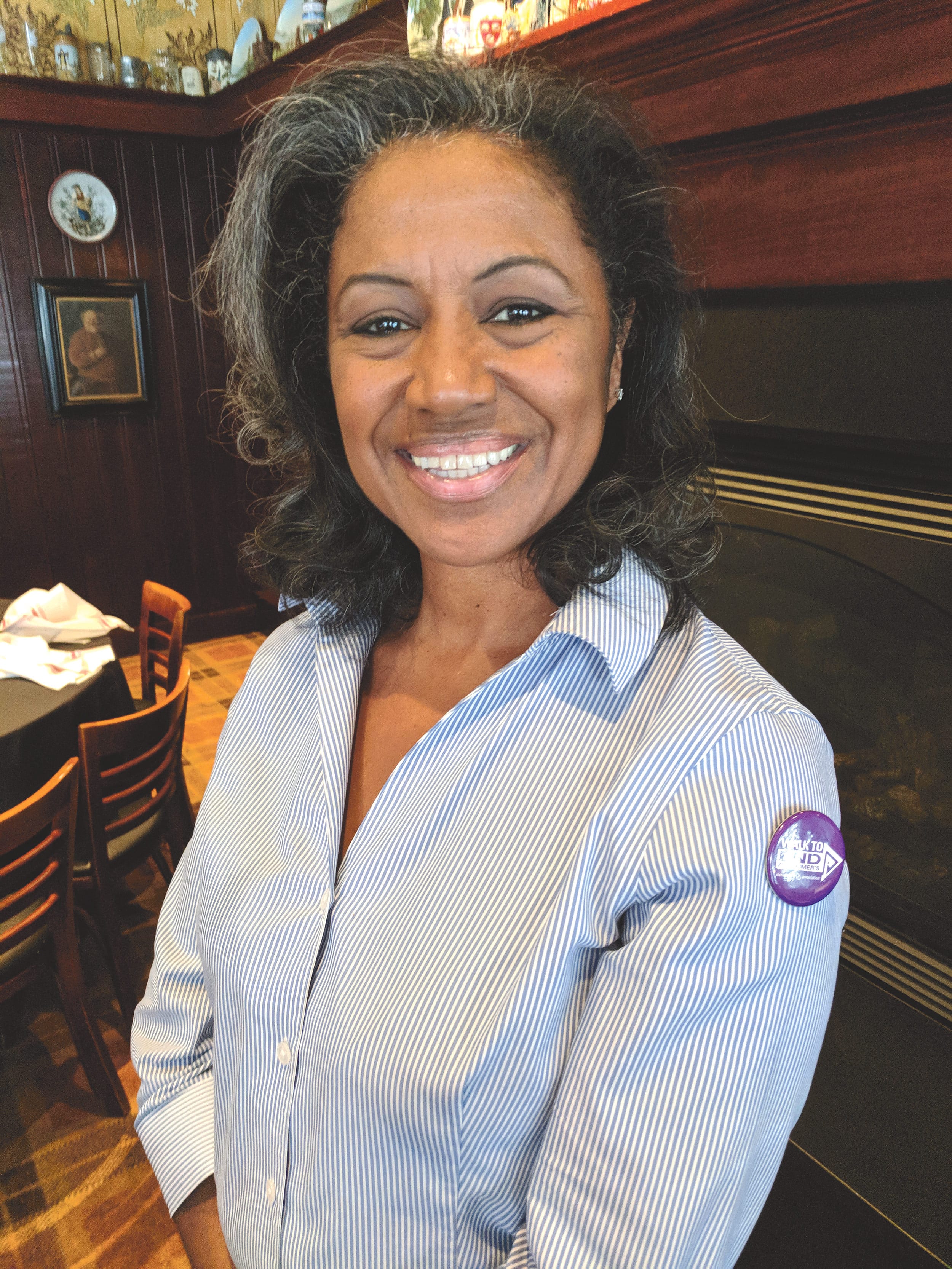Safety Net – Cardiac Rehabilitation Programs Help Keep Hearts Healthy
Lucille Chartier had no idea she had heart problems until a day last October when she got out of the shower, began sweating, and felt like she was going to pass out.
“I knew something was really wrong,” said the 68-year-old Chicopee woman, who was diagnosed with a heart attack after an ambulance took her to the hospital.
While there, she was told about a cardiac-rehabilitation program in a gym, but wasn’t given much information, and since she had never exercised on machines, she was hesitant to sign up.
Several months later, she spoke to Larry Borysyk at Holyoke Medical Center (HMC), and after he explained its program in detail and why it was important, Chartier decided to give it a try.
That was two months ago, and today she would advise anyone who has had a cardiac event to take part in cardiac rehabilitation. She enjoys walking on the treadmill as well as the camaraderie between staff and participants, and says it has helped her gain strength and confidence.
Borysyk, cardiac rehabilitation counselor at HMC, said Chartier’s initial reaction was not u6+nusual.
“Cardiac rehabilitation is life-saving, but it can be a scary adjustment for people who have never exercised in a gym, so we try to reduce their mental and physical stress,” he told HCN, adding that individuals need to slowly acclimate to the equipment. Meanwhile, people who exercised on a regular basis before a cardiac event need to relearn what they can do, and how long and hard they can safely push themselves.
Exercise can be problematic because people can become hyper-vigilant after a heart attack and think any symptom is a precursor to another event. But cardiac rehabilitation can help them learn what is normal.
“Each participant is assessed by a nurse while they are exercising to make sure they stay within their limits,” said Kelley Weider, department director of Cardiac and Pulmonary Rehabilitation for Berkshire Medical Center, adding that patients are connected to wireless telemetry monitors, and if they experience symptoms during exercise they are worried about, they are immediately evaluated.
Holyoke, Baystate, and Berkshire medical centers all have cardiac-rehab programs, and participants exercise in their gyms two or three times a week for 10 to 12 weeks under close supervision. Their blood pressure, heart rate, and heart rhythm are measured during activity, and routines are tailored to meet individual needs and fitness levels.
Participants must have a doctor’s referral, and although the majority have had a heart attack or stent placement, others have had bypass surgery, a heart-valve replacement, congestive heart failure, a heart replacement, or angina.
In addition to monitoring that takes place during each session, participants receive education on topics that include diet, stress reduction, smoking cessation, and other factors that affect heart health, and slowly build strength, get used to exercising, and understand it needs to become part of their lifestyle.
People also learn the importance of genetics and how that factor and their lifestyle have affected their health. “Heart disease does not happen overnight,” Borysyk said.
For this issue, HCN examines the importance of cardiac rehabilitation, how treatment has changed, and how it helps people understand what they do can safely — and when symptoms should not be ignored.
Changes in Care
Borysyk has worked in cardiac rehab since the early ’70s, and has seen changes due to technology and medical advances that allow heart disease to be detected and treated earlier than in the past, which results in better outcomes.
“Coronary-care units were set up in the ’60s, but before that, nurses did everything for patients after a heart attack, including feeding them. They worried about compromising their damaged hearts, and as a result, people ended up as cardiac cripples,” he said, noting that, in the late ’70s and early ’80s, people were kept in the hospital for two weeks after a heart attack, but today they are released after two or three days.
Cardiac procedures and surgeries are not done at Holyoke Medical Center, and in many instances patients who go to their emergency room are transported by ambulance to Baystate Medical Center.
Heidi Szalai, manager of Baystate Medical Center’s cardiac-rehab program, which is the largest in the area, told HCN that, although rehab doesn’t usually start in the hospital, staff members get patients up and moving.
“We want to make sure they’re walking and that it is safe for them to go home,” she said, adding that healing speeds up when they leave the hospital and they are told about programs available to them when they are discharged.
However, cardiac rehab doesn’t begin for a week or two after a person leaves a medical center, especially if they have had surgery, because the heart needs time to recover.
The programs start with individual assessments to determine the best plan of action. In addition to an exercise routine that is created for each participant, they are taught about risk factors that include high cholesterol, smoking, diabetes, stress, nutrition, and lack of exercise.
“They are usually on new medications, and we need to make sure they understand them,” Szalai said, explaining that some prescription drugs may slow their heart rates, and their doctors receive periodic reports about their blood pressure and how the heart responds during exercise, which helps them determine how well a medication is working and if adjustments need to be made.
Lifestyle changes are also discussed. “Some people have always eaten well and are doing everything they should, but need to learn to control stress and cope with it so it doesn’t affect their heart,” she continued, adding that patients have a clinician trained in mindfulness-based stress management. “We tell people that exercise is a dose of medication and has positive affects on risk factors; it helps lower blood pressure, blood sugar, cholesterol, and improves their overall sense of well-being.”
The goal is to get people exercising five days a week, which can make a profound difference because studies show finishing a cardiac-rehab program can lower the likelihood of another event.
Insurance typically covers the cost of the programs, but some people have high co-pays and cannot afford to attend all of the sessions.
When that occurs, staff in cardiac programs do their best in a limited number of sessions. Berkshire Medical Center has a program that pays half of co-pays of $15 or more for qualified individuals, and although it can help, it may not be enough.
“We’ve seen people with co-pays that are $80 a session, so even if they receive financial help, attending 36 sessions may be cost-prohibitive,” Weider said, adding that, in some instances, they have modified the program into six sessions, which is less than ideal, but helps to give a patient security and knowledge about what they can do safely.
“During the intake process, we get a sense of what they’ve done in the past as well as their level of conditioning,” she noted. “About 90{06cf2b9696b159f874511d23dbc893eb1ac83014175ed30550cfff22781411e5} of people haven’t been exercising on a regular basis, but some were running five miles a day.”
Exercise machines are integral to the program and include different types of stationary bicycles, a treadmill, and resistance bands, which are used for strength training.
The final phase of the program is maintenance, and although people can join gyms or exercise on their own, if they still want to be monitored, most hospitals have ongoing exercise programs that cost $40 to $45 per month and are overseen by cardiac rehabilitation staff members who are available to take their blood pressure or put them on a cardiac monitor if they feel it is needed.
Some people like the idea of having that safety net ,and Weider said Berkshire Medical Center’s maintenance program has about 320 participants who want the peace of mind that comes from knowing that, if any concerning symptoms arise, they can be assessed.
“We’ve sent some people to the emergency room, but many times they simply need to be checked out and reassured that they are OK,” she said, noting that a nurse is always available.
Future Outcome
Borysyk says people with cardiac conditions who don’t exercise are at greater risk of not being able to do the things they want as they get older, especially if their diet is poor and they smoke. And although some people avoid cardiac rehab because they want to bury the memory of the event, learning what they can do safely is an excellent way to help ensure their heart health in the future.
“Many studies show that exercise is the biggest modifiable factor to decrease the risk of another heart event,” Weider said, citing one study showing that participants in a cardiac rehab program reduced their risk of another event by 25{06cf2b9696b159f874511d23dbc893eb1ac83014175ed30550cfff22781411e5}.
In addition, it helps participants understand how they should feel when they exercise, what the red flags are, and when they need to call their doctor or go to the emergency room.
“It helps them return to what is important to them in life and gets them into a routine of exercising 150 minutes a week that they can continue when they finish the program,” Szalai said.
It’s definitely an investment of time and money, but one that yields positive results and can lead to a healthier and happier lifestyle.




Comments are closed.